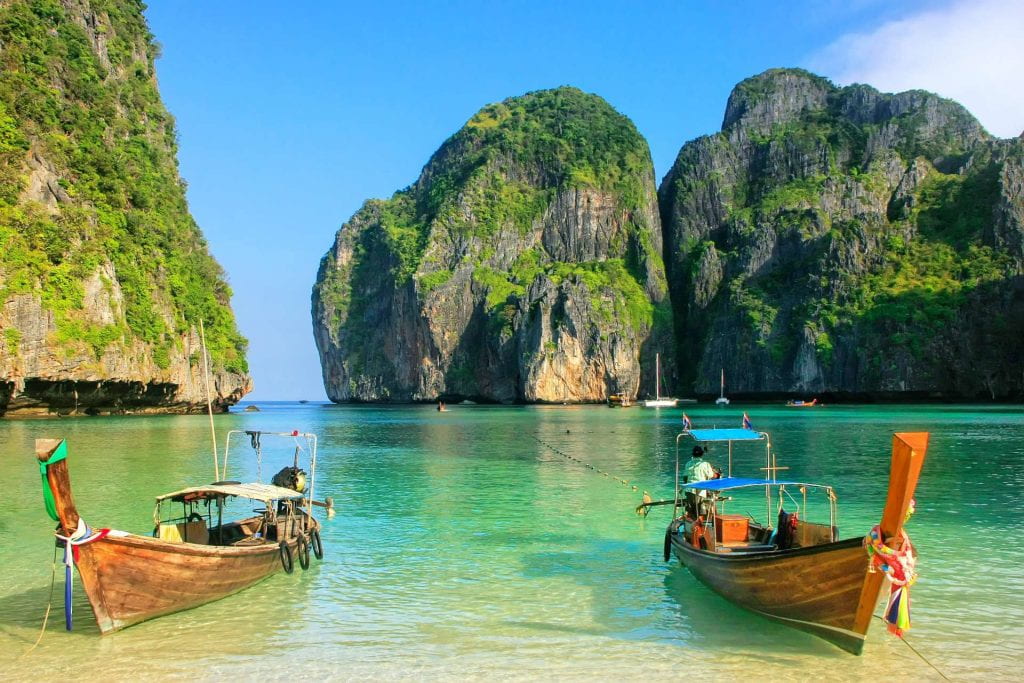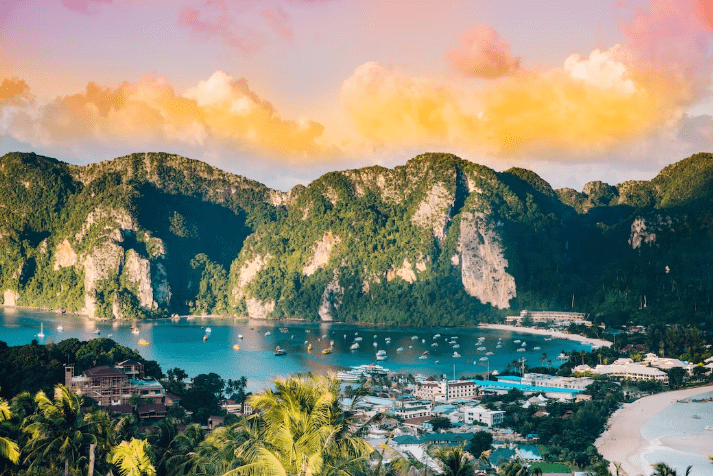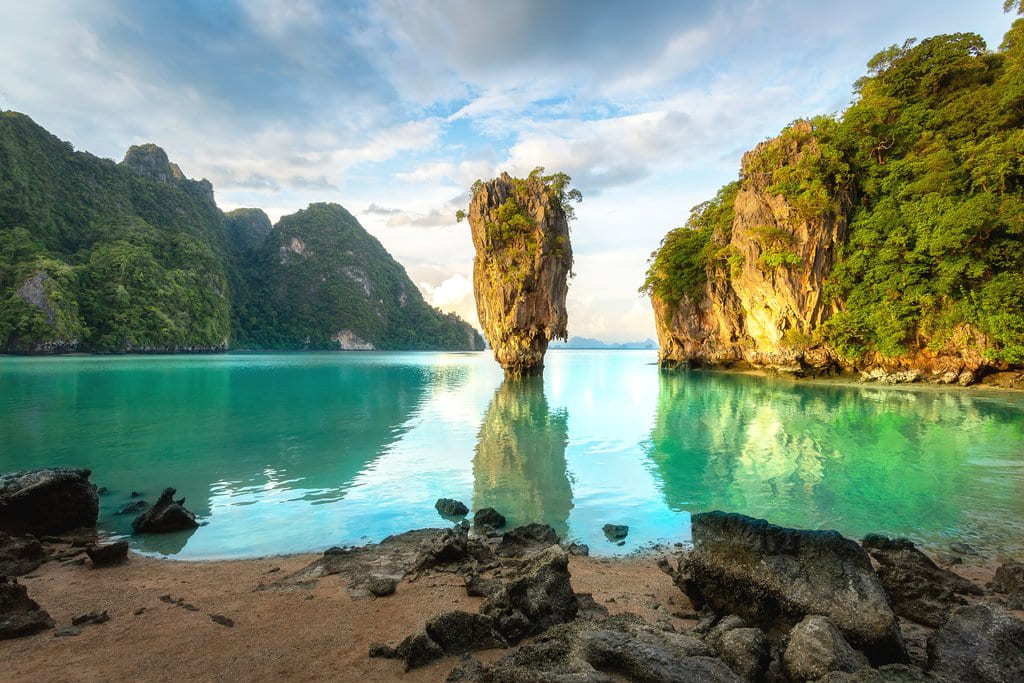Often someone asks us the question, “when to Thailand”? Below we have tried to answer this question by describing the weather, diving, the most interesting events, and the pros and cons of the coming months.

We have also described the most interesting events in our opinion. It is important to know that Thais prefer to have fun rather than work, which makes them eager to celebrate holidays of all nations, including the First of May.
We often read on forums that someone wants to come to Thailand during the rainy season and asks everyone if it’s really “that bad,” probably wanting to hear that it’s not. What can we say: there are no strict rules about the weather here. If someone were to ask an American if it’s warm in America in June, we would reply that yes, it should be warm, although it is sometimes windy, rainy, and very cold. The rainiest months have bad weather and good weather, depending on the state; sometimes November, which “should” be good, is very cloudy and windy, and September is very sunny. But does this mean that there is a rule? Unfortunately, no.
In that case, when to Thailand? There are nations that come to Thailand during the rainy season to see the walls of water, for example, the Japanese like such trips. They take to the streets with waterproof cameras and take pictures. Because the heat and tropical weather have seen almost everyone. And monsoon rain is also a kind of attraction. We wrote more about the rainy season in Rainy Season Thailand. We invite you to visit Thailand all year round.
If you are looking for a place to stay we recommend Luxury Beachfront Villas on Koh Samui.
January in Thailand
Calm sea, sunny, not too hot (sometimes even 28 degrees C) with incredibly blue skies. Perfect time for trips to islands, beautiful bays, or beaches with snow-white sand. Underwater is still a time of very good visibility, and already a good time for encounters with manta rays and leopard sharks. In the big shopping centers, a time of New Year’s price cuts and sales.
- January 1 (public holiday)
- Third week – BO SANG – Festival of traditional paper umbrella makers in Chiang Mai
February in Thailand
Good weather every day, the sky is cloudless and the sea is calm. Probably the calmest time in the Andaman Sea and the water seems to be emerald. A very good time for diving. In February, the Chinese New Year is celebrated. Although not exactly a Thai festival, these four-day festivities are especially noticeable in Bangkok and Phuket City, whose streets empty out like a ghost town, even though it is not a public holiday. The festivities are accompanied by fireworks and the incessant noise of a million firecrackers.
- First week – flower festival in Chiang Mai, unusual floating garlands of flowers
- the first day of the full moon in the third lunar month – “maka buka” day – an important Buddhist festival, a spontaneous gathering of the faithful and 1,250 monks to listen to sermons and teachings of the Buddha.
- From late February to mid-April – kite competition. The most interesting spectacle takes place at Phramane Ground in Bangkok. Teams driving “male” and “female” kites compete, with each other trying to intercept their opponents and pull them down to the ground.
March in Thailand

Most days are sunny. The air is hot and humid. The water reaches 30 degrees, and the best period for underwater observation begins, more plankton attracts groups of manta rays, leopard sharks, and even whale sharks. This is also the nesting season for turtles. The sea is still very calm. An excellent period for snorkeling. The mountain hiking season is coming to an end, and it starts raining every day in the north.
- At the beginning of the month – the Phra Buddha Baht Fair is held at the Buddha Footprint Temple in Saraburi. Crowds of worshippers worship at the beautiful historic temple on the hillside. A bazaar of handicrafts and performances of folk art, chants, and dances.
April in Thailand
Good weather, although there are occasional brief hot rains. Underwater visibility begins to deteriorate, with larger and larger filter fish attracting attention.
- 6 (public holiday) – Day of the founding of the Chakri dynasty (reigning King).
- 13-15 Songkran (public holiday) – Thai New Year. (In 2007, it is the Thai year 2551) Marks the time when the sun moves from the sign of Aries to Taurus. Songkran day falls on the 13th, but the celebration lasts 3-4 days, depending on the location. It is a time of earning merit, bestowing food on monks, releasing birds, fish, and turtles, and also worshipping elders by dousing their hands with fragrant water and variously using large amounts of water. Don’t be surprised if you are doused with buckets of water by strangers on the street. Songkran legend tells of seven daughters of the god, one for each day of the week. Each Songkran maiden wears her own jewel and flower, eats her own delicacies, carries a different weapon, and moves on a different animal. The colorful Miss Songkran parades almost everywhere.
- 13 Turtle release on Bang Tao beach in Phuket
- 14-15 Super motorcycle show on Patong beach in Phuket
May in Thailand
Good weather, at the end of the month the possibility of fleeting short hot rains many times a week, but still rainless and cloudless days. In Pan Nga Bay, the water will remain calm, an excellent time for kayaking, rafting, and snorkeling. The Similan season is coming to an end, with waves and wind on the open sea.
- 5 (public holiday) – coronation day
- Full moon day in the sixth lunar month (public holiday) – Visakha Puja Day – the day of Buddha’s birth, enlightenment, and death
- beginning of the month – Wan Peut Mongkon (public holiday) – a colorful ceremony to start the rice plantation season, celebrated lavishly in Bangkok at Phramane GroundG
- middle of the month – rocket and firecracker festival, dances, parades, a folk festival in every town in the northeast
- Third week – lychee fruit festival in Chiang Rai
- 26-27 International Rugby Championship – Karon Beach and Karon Stadium in Phuket
- late May and early June – fruit festival in Rayong and Chanthaburi
June in Thailand
Hot and steamy, restless at sea, strong winds. Rainfall is frequent, sometimes very strong but short. Multi-day periods of very good weather. Diving very well in island-sheltered areas, visibility improves. The bay is calm. Phuket, Phi Phi, and Krabi are not overcrowded, you can beach, admire the limestone cliffs, and climb. The perfect time to observe animals in the jungle begins. Khao Yai and Khao Sok National Parks become very attractive.
- 17 Tenth Phuket International Marathon
July in Thailand
The weather gets windy, and single days without sun appear. It even rains for more than an hour, several times a day, usually after dinner, in the evening, and in the morning. As a result, it is still possible to use the beach practically every day. The deceptive impression of overcast skies causes many sunburns during this period.
- The full moon day of the eighth lunar month and the following day, Asalha Puja (public holiday), is a commemoration of the Buddha’s first sermon delivered to his first five disciples in a deer forest in Benares, India. On the following day, the 3-month Buddhist Lent begins. There is a fire festival with a procession of large carved candles at Ubon Ratchatani, and a merit ceremony at Phra Buddha Baht Temple in Saraburi.
- 19-22 Yacht Races at Chalong Bay on Phuket
- Halal Food Festival Muslim Kokchanasauk in Talang Phuket
August in Thailand

There are strong winds and rainy days. However, there remain multi-day periods of nice weather. The temperature does not drop below 27 degrees. Be careful with swimming, waves even on the beaches begin. August is considered the best month for sea fishing, almost always returning with tuna or barracuda, which are particularly abundant around the Racha Islands near Phuket.
- 12 – Her Majesty the Queen’s Birthday (a public holiday).
- August/September – Candle festival in Sakon Nakhon in the northeast of the country.
- August 22 – September 3 Chinese Hungry Ghost Festival Por Tor in Phuket Town.
September in Thailand
The rainiest month of the year. The difference compared to other months is huge, although there are sunny days. We dive only in the sheltered bays of the Racha Islands. More rain falls per unit area in this month than in Poland throughout the year. The wind also has the strongest results in the largest waves. This is an excellent time for surfing. Spectacular championship cups in this sport are held on Kata beach in Phuket. Prices are at their lowest at this time, allowing you to organize an economical variant of your vacation. It is also the time of pre-season sales, which makes the shopping frenzy more attractive.
October in Thailand
At the beginning of the month still rainy, but around the middle of the month the weather will stabilize and the “high season” will begin At this time waterfalls become especially attractive.
- The day of the full moon of the eleventh lunar month – the End of the Ork Phansa Fast – Tak Baht Dhevo, is celebrated especially lavishly in Uthai Thani, Bangkok, and Phuket. Monks descend from the hills in long processions and receive alms from the laity. The end of the fast is accompanied by a Chinese vegetarian festival (the next one is October 11-19). The Good Spirit enters selected individuals during the rituals and gives them extraordinary abilities, such as immunity to pain. Many of the chosen perform bloodless self-mutilation in public. Cheek piercing, hanging on a hook by the ribs and other unusual charisma attract spectators with strong nerves. The next four weeks until the next full moon are devoted to Tod Kathin ceremonies, dedicated to collecting donations for temples across the country.
- On the 23rd day of King Chulalongkorn Rama V’s death (a public holiday), thousands of people worship by kneeling in front of a statue of Rama V on horseback in Bangkok
November in Thailand
Great weather, not very hot yet. There are more tourists every day. Visibility underwater is excellent.
- On the night of the full moon of the twelfth lunar month, the Brahmin custom of Loy Krathong, worshipping the Water Spirit Mae Kong Ka, is celebrated. Tiny boats made of banana leaves decorated with lit candles and flowers are deceptively reminiscent of Midsummer Garlands. With the garlands let loose on the water, all worries and problems float away. People rejoice boisterously expecting all the best. Particularly interestingly celebrated in Sukhothai and tourist places.
- 1 – the official start of the season, carnival in Phuket on Bangla Road Patong
- 17-18 elephant show in Surin in the northeast
December in Thailand
Peak season. The sea is perfectly calm, the sky cloudless, and the sun shines wonderfully. Under the water ideal conditions. Crowds of tourists cheerfully and bustlingly celebrate Christmas and New Year. Every hotel and establishment hosts daily games, fireworks shows, dances, and celebrations together. The Laguna hosts the PIMEX International Marine Fair spectacular also for “non-sailors”
- 2 Triathlon at Bang Tao Beach in Phuket
- 3 – Parade of Colors. His Majesty the King and Queen preside over the event at Equestrian Statue Plaza
- 5 – His Majesty the King’s Birthday (public holiday)
- 5-11 Annual Royal Regatta, a sailing competition, and showdown
- 10 – Constitution Day (public holiday)
- 19-20 Super Yachts Meeting in Phuket at Amanpuri Resort gives a chance to see the world’s most expensive yachts
- 31 – New Year’s Eve (public holiday)
When does it rain the least in Thailand?
If by asking us “when to Thailand” you mean rain, the least average rainfall in Phuket is in the months of February, March, January, December, and April, consecutively.

